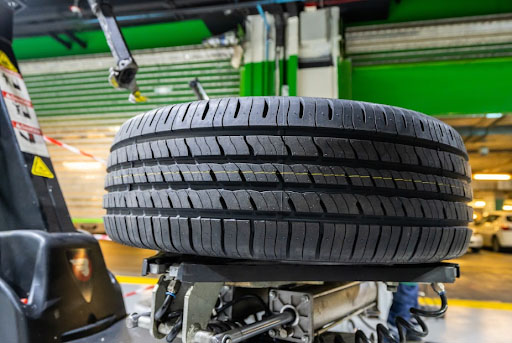Signs, Diagnostics and Repair Solutions to Prolong your Tyres' Life

Why are tyres important, and why do they deserve your attention and care?
Here’s the short answer:
Your road safety and overall driving experience depend on your tyres' condition. And when you are driving over 100kph, it's the tyres that keep your vehicle stable and under control.
High-speed tyre bursts can have severe consequences; therefore, it is important to look after your tyres as it is important to take care of the engine and other critical components.
This blog will discuss a few common signs that indicate a problem with your tyres, along with proper diagnostics and solutions. So, let's get started.
#1 Punctured Tyre Vs Under Inflated Tyre
Modern tyre manufacturers are rolling with cutting-edge technology that makes their tyres unfettered by a minor puncture. That means if a nail pierces through the tread, the tyre will lose a small amount of air and will continue to roll without a problem.
Nonetheless, it is important to locate the puncture and repair it to avoid further damage to the tyre.
Puncture
If you notice a slight drop in the air pressure of one of the tyres, the easiest way to spot a puncture is to inspect the tyre closely for a complete rotation. If you find a puncture, good. If not, bring your car down to our tyre shop in Ajman and let one of our technicians check your tyres for any punctures and repair them if necessary.
Besides plugging the hole, we will also place a rubber patch on the inner tyre lining to seal the hole properly so that it never leaks air again.
Under-inflation
Under-inflation is when the tyre pressure drops below the recommended level, and that can have major consequences. For instance, the weight is not distributed evenly across the tyre's width but remains concentrated on the edges. As a result, the tyre wears off at the edges.
To avoid this situation, always maintain the optimum tyre pressure according to your vehicle's manual.
#2 Uneven or Excessive Tread Wear
If you notice premature tread wear at the tyre's edges, it may be due to under-inflation. On the contrary, over-inflation causes abnormal wear at the center of the tyre.
While these problems can be prevented by adjusting the tyre pressure to the optimum level, certain symptoms of tread wear will require additional maintenance measures.
For instance, premature wear on either edge of the tyre indicates poor alignment. This means your tyres need to be adjusted for toe-in or toe-out.
Uneven tread wear across different sections of the tyre might indicate a major suspension problem or poor balancing. In that case, it is important to bring your vehicle in for a quick diagnosis. Our technicians will get to the root of the problem and recommend the best course of action.
Tyre Replacement
Most car owners aren't sure when they should replace their tyres. Well, here's a simple way to find out:
All tyres come with tread-wear indicator bars. When these bars surface across the tyre's width, it's time to replace the tyre.
Replacing tyres can be a major expense. So, if you are looking for affordable yet reliable options, you can go with Sumitomo tyres or Zeetex tyres.
#3 Damaged Sidewall
The tyre's sidewall may deteriorate in different ways. The signs of damage include cracks, bulges, indentation and scuffs on the sidewall. All of these signs are a red flag except the indentation.
In layman's terms, an indentation can be described as a manufacturing defect that does not affect the performance or safety of tyres. These indentations are formed due to a manufacturing error, like a small permanent wrinkle in a shoe or shirt.
However, a tyre technician must examine other symptoms of sidewall damage mentioned above to rule out the possibility of a safety hazard. If there's a noticeable bulge or bubble on the sidewall, it may be because of overinflation or a puncture repair done wrong. In such cases, the best way forward is to replace the tyre.
#4 Issues in Handling
The condition of your tyres has a lot to do with your experience behind the wheel. If your vehicle is pulling to the side, it indicates poor alignment or underinflation/overinflation in one of the front tyres.
If your steering wheel vibrates at high speed, it's a wheel balancing issue, or probably there's a small bend/dent in the rim. While you can continue to drive the vehicle with a balancing issue, it would be best if you don't. Get it fixed by a technician as soon as possible to avoid premature, uneven tyre wear.
Furthermore, worn-out tyres can put you in a dangerous understeer situation around the corners, especially when going a bit fast on wet roads. Understeering is the vehicle's tendency to turn less sharply than is intended – in this case, it happens due to poor traction.
Repairing the Tyre
Tyres are made to last tens of thousands of kilometers and do not bend or crack under ideal driving conditions. However, tyres do get punctured occasionally. While a plug-on repair gets you back on the road right away, it may not be a sustainable repair option. To ensure the tyre does not leak air from the same puncture, it is important to patch it both inside and outside.
For that, the tyre is first demounted and inspected thoroughly for any puncture. Once the punctures are patched, the tyre is mounted back on the rim and inflated to the recommended air pressure. To double-check the repair work, the tyre is inspected again for any leakage.
Apart from tyre repairs and replacement, UAETyres has a fully equipped service center for Audi, BMW, Toyota, Honda, Hyundai, Porsche and Volkswagen repair in Sharjah. If you need any help with your tyres or vehicle repairs, visit us today.



